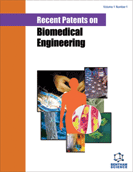Abstract
Treatment of large bone defects poses a real challenge to the orthopaedic surgeon. The surgeon often times calls on creativity in the form of bone graft substitutes to help mend large bone defects. The bone graft substitutes used today include inorganic compounds such as calcium phosphate, osteoconductive composites which act as a scaffold to allow for new bone growth, and some may include osteoinductive proteins which provide signals to the microenvironment promoting osteogenesis. Autologous bone grafts are still the gold standard and this creates a risk of harvest site morbidity and the defect may be too large for autologous bone alone. Injuries requiring tendon or ligament reconstruction rely upon the use of bone blocks in the form of bone-tendon-bone grafts, which can also create a hurdle for the orthopaedist. We have reviewed the current literature and recent patents available on bone graft substitutes and bone blocks for bonetendon- bone grafts and have described new biomaterials and therapeutics available to the orthopaedic surgeon.
Keywords: Biomaterial, BMP, bone, BTB, ceramic, composite, DBM, defect, glass, graft, inorganic, ligament, organic, osteoconductive, osteoinductive, scaffold, synthetic, tendon.
 1
1

